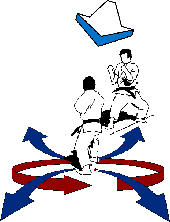|
Sabaki is a unique method of meeting an attack by combining defence and offense into one. Sabaki uses one of four fundamental circular movements in response to an attacker's thrust. These movements carry the defender to the outside- left or right of an attack, moving either slightly forward or backward. In each case, the defender move's to the attacker's back side. This limits the defender's exposure to frontal attack. In addition, it allows the defender to develop a "blind spot" in the attacker's position. Once the defender has developed this "blind spot", he/she can take strategic advantage of this position by entering that "blind spot" and countering effectively with various combinations of punches and kicks. No matter what the distance - short, medium or long - this strategy of moving outside and to an opponent's "blind spot" is essential. In Ashihara Karate the practitioner learns to be aware of three types of distances and the Sabaki that applies to each.
 |
What does Sabaki mean?
Sabaki is a difficult concept to translate from Japanese. Broadly speaking, Sabaki refers to movement, often involving a concept of control, sometimes implying preparation for a subsequent movement. For example, Sabaki can be used in reference to training a horse. The rider performs certain movements in an effort to control the animal, in order to make the animal behave as he/she wants it to.
Kancho Hideyuki Ashihara has adopted the word Sabaki to epitomise the essence of this style of Karate. In Ashihara Karate, Sabaki describes the movement made by a defender stepping out of line of an attack, into a position from which he/she can launch a counter-attack. This controlled movement, in preparation for a subsequent advance, is the basis of the strategy of Ashihara Karate: the combination of defence and offence into one ... SABAKI.
|